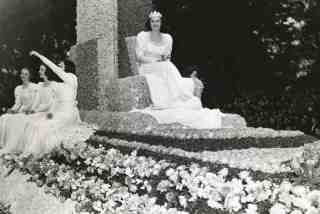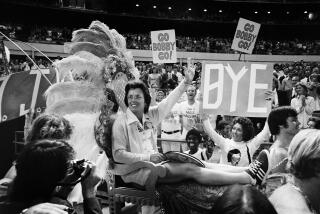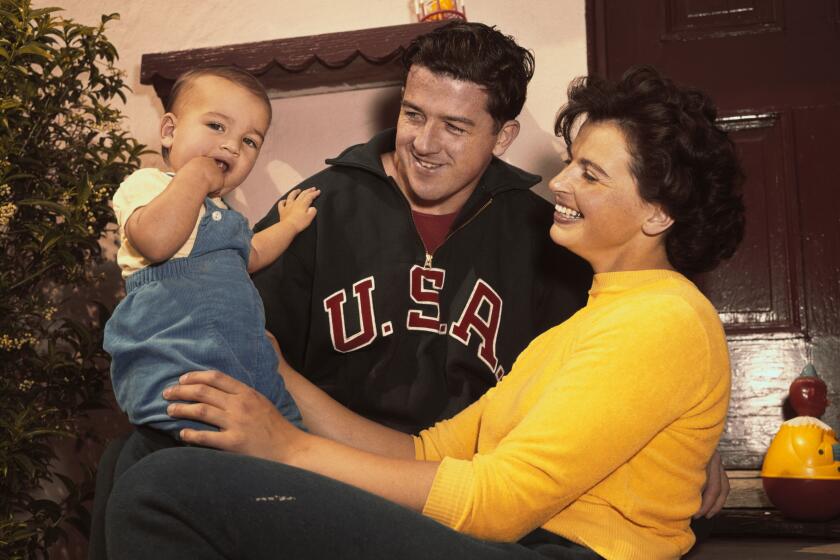Gussy Moran dies at 89; tennis player caused Wimbledon uproar with short skirt
Gussy Moran, who gained both international fame and notoriety by wearing a short skirt and lace panties in the 1949 Wimbledon tennis tournament and who lived a life of celebrity for many years, died Wednesday night in her small Los Angeles apartment in the shadow of Paramount Studios. She was 89.
According to a friend, Lovey Jurgens, Moran suffered from colon cancer and had been home about a week after an 11-day stay at Good Samaritan Hospital.
Moran was born Sept. 8, 1923, and grew up in a Victorian home on Ocean Avenue in Santa Monica that still stands. Its address is 1323, and it was built by her grandfather in 1870. Her father, Henry, was a sound technician at Universal Studios and her mother, Emma, a homemaker.
She started playing tennis at Santa Monica High School and always said she loved living in the big old house because she could “run out the door and across the street to the ocean.” Among those encouraging her to pursue her tennis career was movie star Charlie Chaplin, who also got her auditions for bit parts in movies. She landed a small role in the 1952 movie “Pat and Mike,” with Spencer Tracy and Katharine Hepburn.
Her tennis talents took her to a No. 4 ranking among U.S. women and into the seventh-seeded spot in the 1949 Wimbledon tournament. Moran, whose given name was Gertrude and always preferred to be known as “Gussy” not “Gussie,” wanted to make a fashion splash at Wimbledon that would be in line with her outgoing personality and showcase her pretty legs. She asked one of the official hosts, Ted Tinling, to help her design an outfit. Tinling did, and an uproar ensued.
The skirt was well shorter than the Wimbledon norm of the day and allowed her to show off lace panties. The photographers scrambled for low-angle shots and Wimbledon officials fumed and called her, and her outfit, a disgrace. She lost in her first-round singles match, but made it to the final in doubles before losing. She also reached the semifinals of the U.S. Open in singles and won other national titles in singles and doubles.
She ended up being overwhelmed by the attention and may have never reached her potential because of the Wimbledon incident. She later told friends that, when she got home, she took the lace panties and dumped them in a garbage can.
In the days when Moran played, tennis was mostly an amateur sport. Moran left the amateur circuit to turn pro in 1951 and travel with a touring group organized by Bobby Riggs. That turned out to be a financial, athletic and personal disaster. She never got the money she was promised, she lost most of her matches to nightly opponent Pauline Betz, and her future was left up in the air.
She was a television sportscaster in Los Angeles for a while before moving to New York to do the same. During one stint in the mid-1950s, she did pregame and postgame feature shows on the Dodgers, where she met and dated sportswriter Roger Kahn, eventual author of the classic baseball book “The Boys of Summer.”
“She knew about as much about baseball as I knew about polo,” Kahn said. “But she was a delightful person, just great fun to be with.”
She never quite escaped the pretty-legs and lace-panties imagery, nor did she always run from it. From the moment she took the court in that infamous moment at Wimbledon in 1949, she went from being Gussy Moran to “Gorgeous Gussy” Moran. The name stuck for the rest of her life and the fame lasted a long time. She had a ship, a play and a racehorse named after her.
Kahn said Moran used to play volleyball with him during spring training in Vero Beach, Fla., “and I’d look up and there would be 20 baseball players watching.”
Kahn said that the Dodgers’ director of publicity at that time, Red Patterson, once asked her to leave training camp because she was “a distraction.” Tennis legend Jack Kramer, who traveled on the pro tour with her, later called her “the Anna Kournikova of her time.”
She married three times but had no children. The first marriage, at age 19, to a pilot, was annulled. Her second, to trucking executive Eddie Hand, ended in divorce. Her third, to Los Angeles-area lawyer Frank “Bing” Simpson, also ended in divorce. For one of her engagements, Chaplin held a party at his mansion.
She eventually moved back into the home on Ocean Avenue in Santa Monica, but couldn’t afford to keep it after her mother died. In 1986, after battling tax liens and turning down an offer of $1 million for the house, she was evicted. She moved into a small apartment off Melrose and, with a small amount of Social Security and help from friends — including monthly checks from an anonymous person in Australia often wired to the Los Angeles Tennis Club — stayed there until her death.
One of her final jobs was working in the gift shop at the L.A. Zoo.
More to Read
Start your day right
Sign up for Essential California for the L.A. Times biggest news, features and recommendations in your inbox six days a week.
You may occasionally receive promotional content from the Los Angeles Times.







